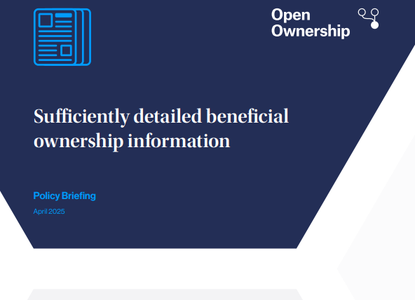Attention to detail: A core principle in beneficial ownership transparency

Photo by David Clode via Unsplash.
Beneficial ownership transparency (BOT) is a well-established policy reform to promote integrity in the business environment and support the fight against financial crime, corruption, and tax evasion. Yet simply having a beneficial ownership (BO) register is not enough. It is the responsibility of both policymakers and the agency administering the register (that is, the registrar) to ensure that the information it acquires has enough detail to advance a jurisdiction’s policy aims.
A new policy briefing by Open Ownership emphasises the importance of having sufficient detail in BO information, and provides guidance for policymakers and registrars on how to achieve this. Detail is one of the nine Open Ownership Principles for effective beneficial ownership disclosure.
Why the level of detail matters
BO declarations need sufficient detail for the register to achieve its main objectives for processing BO information, i.e. 1) identifying the individuals and legal vehicles in a declaration; 2) understanding the relationships between them; and 3) ensuring the data is auditable and usable.
This requires several balancing acts. First, policy makers and registrars must balance the amount of information that is collected directly through BO declarations with what is retrieved from other sources in order to complete and verify a declaration. They must also consider how to lower the burden of compliance without undermining the comprehensiveness of the information. Furthermore, ensuring a BO disclosure regime is legally robust requires balancing the level of detail with privacy frameworks, ensuring there is a robust and broad legal basis for requiring BO disclosure. Finally, the level of detail appropriate to the national implementation context must be balanced against the need for information to be interoperable with other datasets.
The briefing offers considerations for how to manage these balancing acts by outlining three key areas to shape the effectiveness of BOT reforms:
Gathering detailed information: Registrars can retrieve information from existing sources, collect it directly from individuals, or a combination of both. The best approach depends on factors like data availability, existing systems, and user needs. Pre-populating digital forms with information retrieved from other government sources can reduce redundancy and errors and is preferred where possible, while direct collection ensures that all necessary data is captured where retrieval is not possible.
Developing robust legislation: A strong legal framework is essential for gathering, processing, and sharing BO information. Legislation should clearly specify who must submit what information, when, and to which authority. It should also be flexible enough to adapt to evolving standards and needs. Importantly, legislation should focus on defining the information fields to be gathered (i.e. collected or retrieved), rather than the specific design of data collection forms. Finally, the concept of data minimisation should guide decisions, ensuring that only necessary information is collected and stored.
Achieving the registrar’s objectives: The primary consideration for choosing which information fields should be gathered is how well they help the registrar achieve its three main objectives. This requires registrars to take a range of measures, including collecting reliable identifiers (such as passport numbers or tax identification documents) for identity verification; capturing details about both direct and indirect relationships in order to understand ownership networks; and ensuring data is structured and changes are tracked to make it auditable and easy to use.
As discussed in a separate research paper on understanding beneficial ownership data use (forthcoming), policy impact from BOT reforms is generated by actors using BO information to answer their questions and reach actionable insights. Whether they are using this information to help manage business risks, investigate tax evasion, or improve public procurement, many user needs overlap and require the right level of detail to be met. For example, users need to be able to make connections across datasets and to be assured that there is a baseline level of accuracy. A registrar meeting the objectives set out above is key to achieving both.
Key takeaways for policymakers and registrars that emerge from this work include the following considerations:
- Think beyond simple registration: Effective BOT requires more than just setting up a register – the level of detail in that register must be sufficient in order for it to be useful.
- Leverage existing data: Explore opportunities and prioritise retrieving information from other government sources to reduce the burden on those making declarations and improve data accuracy.
- Prioritise data usability: Ensure the data is structured in a way that makes it easy for users to analyse and draw insights. This includes using reliable identifiers, capturing information on relationships, and keeping the data up to date.
- Don’t forget about privacy: Balance the need for detailed information with the privacy rights of individuals. Adhere to data minimisation and ensure appropriate safeguards are in place.
- Engage with stakeholders: Conduct research with those who will be using the register both to make declarations and to access and use the information. This will help ensure the register meets users’ needs and is designed in a user-friendly way.
By giving appropriate attention to the level of detail in BO declarations, jurisdictions can create BO disclosure regimes that are not only compliant with international standards but also effective in achieving their intended policy goals. Having sufficient detail is one of the main factors that transforms a simple BO register into a powerful tool for transparency and accountability.
